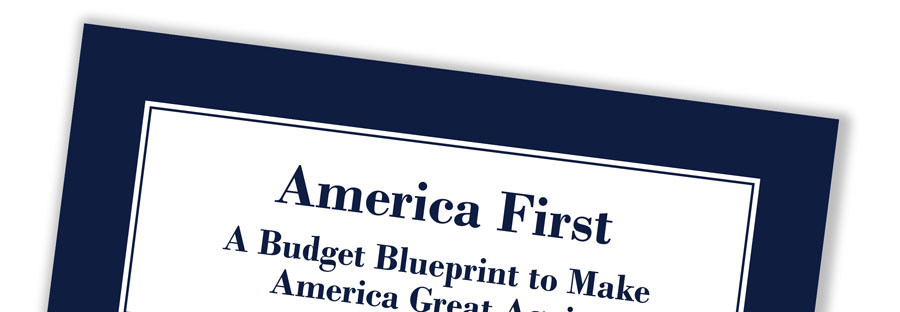
What got cut in Trump’s budget proposal
The White House released its “skinny budget,” a simplified version of the administration’s federal budget proposal for the 2018 fiscal year. It differs radically from President Obama’s budget proposals and includes large cuts in discretionary spending and additional money for defense.
Initially targets discretionary spending
President Trump’s first budget does not touch mandatory spending programs like Social Security, Medicare and Medicaid. Only annual discretionary spending, which makes up about a quarter of the total budget, was addressed by the president for the 2018 fiscal year, which begins Oct. 1. His proposals on taxes and any changes in mandatory spending laws will come out in a more detailed budget later.
Current projected spending for 2017
Shifts money to defense programs
For the current fiscal year, discretionary spending is about evenly split between defense programs and nondefense programs, such as transportation, agriculture, law enforcement and education. Trump wants to increase defense spending $54 billion but he'll need to work around spending caps set by the Budget Control Act.
Current spending caps
Losers and winners
In percent terms, the Environmental Protection Agency (EPA) is the hardest hit under the proposed budget. Veterans Affairs, Homeland Security and the Department of Defense all see increases.
Change from current budget
Cuts State Department and USAID by almost a third
The cut to State is roughly 30%. The budget would eliminate money for the programs aimed at combating global warming, ending U.S. support for the United Nations’ climate change programs. It also cuts funds for the World Bank and other international development programs.
- Eliminates the Global Climate Change Initiative and ceases payments to the U.N. climate change programs
- Reduces funding for multilateral development banks, including the World Bank, by $650 million over three years
- Maintains funding for HIV/AIDS treatment and malaria programs
Cuts in health programs
The budget calls for a nearly 18% cut next year at Health and Human Services to “help focus resources on the highest priority research.” Among the biggest targets are the National Institutes of Health. Trump would also cut $4.2 billion in grants, including the decades-old Low Income Home Energy Assistance Program, which helps low-income Americans with heating bills.
- Eliminates $403 million in training programs for nursing and other health professions
- Reduces the National Institutes of Health’s (NIH) spending by $5.8 billion, including administrative costs and federal contributions to research funding
Slight increase for Homeland Security, provides initial funding for border wall
The budget requests $2.6 billion to pay for “high-priority tactical infrastructure and border security technology,” which would include the first parts of the president’s proposed wall along the U.S.-Mexico border. That’s on top of additional money the administration already has proposed for the current fiscal year.
- Adds $314 million to recruit and train 500 new Border Patrol agents and 1,000 new Immigration and Customs Enforcement law enforcement personnel
- Adds $1.5 billion to detain and deport immigrants who are in the country illegally
- Cuts funds for federal disaster-preparedness programs
Cuts housing programs
Changes to the Department of Housing and Urban Development budget leave less money to help poor people pay their rent. The Community Development Block Grant program, which funds programs aimed at improving local communities, would also be eliminated.
- Eliminates funding for Community Development Block Grants, cutting $3 billion
- Eliminates funding for community development groups that create affordable housing (Section 4)
Cuts agriculture programs
The White House wants to reduce staffing and eliminate some grant programs.
- Reduces National Forest System land-acquisition programs
- Reduces some funding for statistical capabilities but still funds the Census of Agriculture
- Eliminates the water and wastewater loan and grant program
Increases budget for Veterans Affairs
The proposed budget increases discretionary spending for the Department of Veterans Affairs by 6%. The White House also asks Congress for mandatory spending increases.
Slashes 30% of the EPA budget
A long-hated agency among Republicans, Trump aims to slice the environmental regulator's overall budget to $5.7 billion.
- About 3,200 positions and more than 50 programs will be cut
- Drinking and wastewater infrastructure will be a top priority
- Cuts funding for the Clean Power Plan and international climate change programs
Shifts Labor's responsibilities to states
Cuts to the Labor Department reduce the agency by 21% and affect funding for job-training programs.
- Decreases federal support for employment services programs for unemployed seniors and disadvantaged youth, shifting the responsibility to state and local agencies
- Cuts $60 million from the Bureau of International Labor Affairs
Cuts to NOAA and consolidation within Commerce
The budget proposes a 16% cut to the Commerce Department’s overall budget while boosting the Census Bureau’s funding in preparation for the 2020 census. Proposed cuts to the National Oceanic and Atmospheric Administration would hit scientific research.
- Increases Census Bureau budget by $100 million for information technology upgrades and field infrastructure
- Eliminates the Minority Business Development Agency
Education Department cut 13.5% while increasing funding for charter schools
Betsy DeVos, Trump’s secretary of Education, has long been a proponent for voucher programs and private schools in Michigan. The budget boosts charter school funding by $168 million and adds $250 million for a new private school choice program.
- Eliminates or reduces more than 20 programs, including Striving Readers, Teacher Quality Partnership and International Education
- Maintains $13 billion in funding for IDEA programs that service students with disabilities
Defense Department gets 10% bigger
Already the largest department in the federal government, the president wants to expand military spending to $574 billion in 2018. Priorities include include cybersecurity, the war against Islamic State, Armed Forces training, equipment and infrastructure. An additional $2 billion goes to non-Defense programs and $65 billion more is allocated outside this budget to support ongoing overseas operations.
Sources: Congressional Budget Office, National Archives, Office of Management and Budget, National Priorities Project
Overall current projected spending levels for fiscal year 2017 based on Congressional Budget Office projections from January.